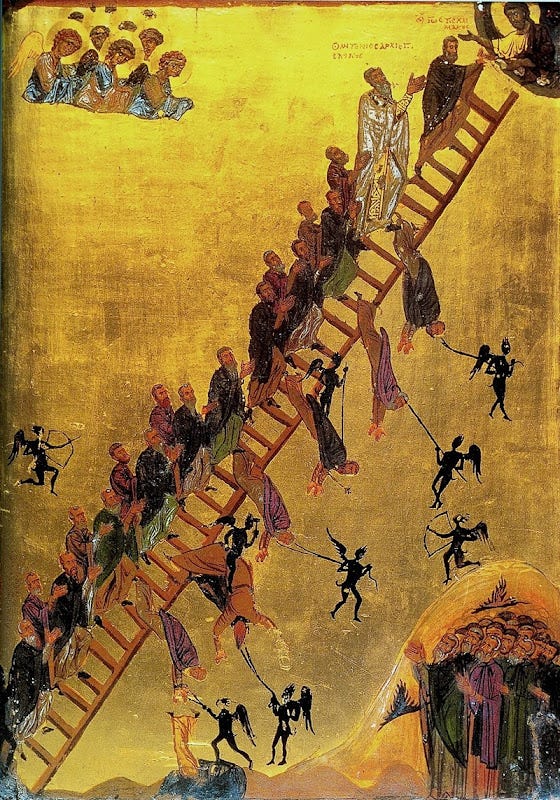Spirituality is a technology. Or rather, it’s like going to the gym, really. Once you push past the superstition and the dogma surrounding the whole affair, you find that spirituality is really straightforward and can be boiled down to a few key concepts. Obviously, one has to at least be open to the idea that there is a non-material reality worth understanding and interacting with. But, with that qualification out of the way, the first question is “why” or rather “for what purpose” and then, the most important question, the one that separates the noobs from the pros is: “how does one master it”?
Fundamentally, esotericism boils down to the idea that you, personally, have to put in the effort to develop yourself spiritually. This means applying spiritual practice to one’s life. The goal of almost all esoteric schools is to achieve a higher state of being. This is conceptualized in many ways, but the most common explanation is that one has to make contact with one’s so-called “Higher Self” or the “Christ Self” and so on. Basically, the theory goes that the state that the average person finds themselves in is actually what can be considered a “lower” state of awareness and being and that one could, instead, be operating at a “higher” one. The goal of spiritual work is to “awaken” to this higher state.
There, that’s basically the gist of what the Neoplatonists, Gnostics, Hermetics, Hesychasts, Alchemists, Gurdjieff, Mouravieff, Benner, Castenada, Banes, Atkinson (and probably some other big ones that have slipped my mind) were trying to get at.
And, one achieves this higher state by mastering various spiritual techniques. The most basic and the most important one is meditation. Meditation literally changes the brain waves that the mind sends out and receives. Don’t take my word for it though, the CIA and all the secret police agencies did their homework on this stuff in the 70s.
A basic level of mediation competency is necessary to master more advanced techniques like astral projection and lucid dreaming and self-hypnosis. In the same way that, say, a boxer has to master the jab and the hook and the duck, the spiritual technician has to be able to shift out of Beta state (often referred to as monkey mind) to Alpha and then Delta and, eventually, Theta. In these altered states, one can begin having spiritual experiences.
Meditation is simply the process by which one enters Alpha state. This is done by either focusing intently on a specific something (traditionally a candle flame, or one’s breath, or heartbeat) or by focusing on everything at once (full-body sense feeling) with the goal of silencing internal chatter. Once internal chatter can be silenced at will through applied focus, other altered states become possible as well. The best explanation that I have come across is that one can “hear” one’s Higher Self only when one quiets the fears, worries and incessant chatter of the Lesser Self.
That, in a nutshell, is the “how” of spirituality.
As for the “why” and the “for what purpose” - well, that’s a bit more subjective.
The monks of Mt. Athos wish to attain the “Christ-state” by undergoing “Theosis” i.e., becoming Christ. Others want to assuage their fear of death by verifying for themselves that materiality is an illusion, or at least, only part of the whole story and that the non-material world does indeed exist.
Using similar techniques the world over, spiritual gurus are able to share insights that they have gleaned by peering at the world through altered states of mind. Many, like St. Paul and Father Seraphim Rose, report that the lower heavens are full of archons or demons that keep us prisoner in this world. Both men saw spirituality as a means of learning how to make it past the gauntlet of dark angels that attack the soul after death and eventually make it to heaven. The “aerial tollhouses” that Father Seraphim Rose mentions in his book Life After Death are quite similar to the gatehouses guarded by monsters that the Gnostics spoke about back in their day. Orthodoxy, being the most mystical branch of Christianity and influenced more by Paul than Peter, still retains a conception of this struggle after death to make it to heaven. This is called Мытарства (mitarstva).
But, fair warning, official priest-based Orthodoxy forbids lay-people from practicing spiritual techniques, even going so far as to say that meditation is a sin. Only a select few are allowed to pursue spiritual self-development, the rest simply have to settle for the faith-based approach.
Funny enough, sects of Buddhists share a similar conception of the intermediary realms between our world and the higher, better world that we ought to aim to reach. Some believe that a Demiurge-like entity (Mara) tried to stop Buddha as he was about to escape the endless cycle of birth and death on this plane of existence. Once again, you have to learn to look past the aesthetics and decode the jargon to get to the core of the matter.
Other religious schools, however, take a different view on the same or similar reported spiritual phenomenon. Mainstream religious thought in the Abrahamic faiths is centered around encouraging the faithful to worship the entity that most esoterics eschew. Now, both groups acknowledge the reality of a temperamental, jealous and powerful entity that either created the world or claims to have, that demands worship and obeisance from us all. But, clearly, beyond that point is where the consensus ends. See, spiritual techniques can only open one’s eyes to these higher realities, but cannot make up one’s mind about how to interpret and react to the information that one is exposed to. Just because there is a surprisingly consistent consensus about the nature of the metaphysical reality just above ours doesn’t mean that there is a consensus about how one ought to interpret or react to these revelations.
Fundamentally, the individual has to choose what to do with the knowledge that one is exposed to over the course of one’s spiritual journey.
Hesychasm, for example, is full of warnings issued to the would-be spiritual practitioner. The greatest danger that is constantly hammered into the acolyte is the risk of falling into “Prelest” i.e., taking a wrong turn during one’s spiritual journey. Monks have been known to be driven to madness and self-destruction as a result of their spiritual training and it is a phenomenon akin to falling to the dark side of the force.
Having said all that, spiritualism isn’t really different from any other technique or technology in that regard.
A man who learns how to shoot a gun can either become a school shooter or a war hero. Similarly, a psychiatrist can use his knowledge to help his patients or sadistically toy with their psyches to extract money and foster dependency. The risk of misusing a technology or a technique is present in all walks of life, and even along the path that we must all take after we leave behind our mortal coil as well. Risks and dangers have to be taken seriously, but they cannot be used as an excuse for inertness and sinking into entropy. Despite the danger of driving just about any vehicle, most of us still hop into a car to get to work every day, no?
So, why then do we refuse to learn about the practice of spirituality and begin putting it to use in our daily lives?
We complain about the meaninglessness of modern existence, do we not? Why then do we refuse to pick up the inheritance that has been bequeathed to us by generations of mystics who have already show us the way? It is because we have stopped being doers and have instead, contented ourselves with simply being believers. Until we learn to reapply correct practice (praxis) to our politics, our daily lives and, yes, our spirituality, we will, as a people, continue to spiral around the drain and only sink further into entropy and decay.






I keep appreciating your common sense writing on metaphysics, far from the incomprehensible philosophical blather that it has become today.
Two comments. The contemplative orders of the Catholic Church have been under unceasing attack since the 18th century and its much praised Enlightenment. They have been perceived as of no social use, actually a waste of people and resources. In parallel took place a continuous deemphasis on spiritual life and spiritual development. That has left Catholicism as a purely faith-based religion with a large social presence. The hierarchy ended up noticing the nefarious consequences of the absence of spiritual life and has lately reintroduced orison, a simple form of meditation.
Reformation abolished mysticism in favour of studying the Bible. The Rosenkreutz of the 17th century and the Free Masonry of the 18th century are attempts at reintroducing mysticism in a Protestant world devoid of it but where a longing for it persisted. The original Rosenkreutz subsided. The Free Masonry degenerated into a convoluted ritualistic organisation where initiates aim at power over their societies instead of their own spiritual advancement. The worldly focus of Protestantism overwhelmed the founders purpose.
I believe in God but have never been a steady church goer mainly out of a lack of respect for most church leaders I have met. I have found I have the same reaction to Buddhist monks.
I was surprised to read orthodox and catholic Christians (especially recent converts) dismiss meditation as evil. Lowering the noise in my head has driven me closer to God not further away.
Underlying the demonizing of meditation (and yoga of course) seems to be a belief that Christianity should be approached in the same way that the left approaches Science! You passively listen to experts and don't question or actively seek.
Maybe that is a safer route but I find it alienating.